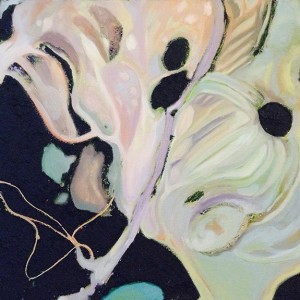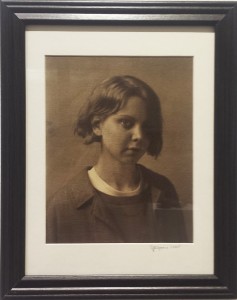In this mesmerizing work by Carolyn  Jacobs, part of The Missing Mountains series, the artist explores the relationship between beauty and destruction. Growing up in the mountains of Eastern Kentucky was to bear witness to both on a daily basis. In works like Hazard, Kentucky, she utilizes coal, oil, wax and reductive techniques to create aerial landscapes that hint at the destruction left by strip mining.
Jacobs, part of The Missing Mountains series, the artist explores the relationship between beauty and destruction. Growing up in the mountains of Eastern Kentucky was to bear witness to both on a daily basis. In works like Hazard, Kentucky, she utilizes coal, oil, wax and reductive techniques to create aerial landscapes that hint at the destruction left by strip mining.
Carolyn Jacobs has been a beloved Studio Art Instructor for 18 years at CPCC, who teaches Drawing I and II, Figure Drawing I and II, Design I, Watercolor, Art Appreciation, Painting I and II, and Portrait Painting. Her impressive accolades include an MFA in Drawing from the University of Tennessee, and a BFA in Painting from Eastern Kentucky University. She is on the National Steering Committee for the League for Innovation Art Competition; in 2007 Carolyn received a Parr Fellows Award for Excellence in Teaching and Advising, and in 2014, she was awarded Instructor of the Year.
The timeless magic of symmetry, mystical creatures from Russian folk tales and a fascination with nature all combine to inspire artist, Advertising & Graphic Design Instructor, Nelli Levental, in her new series, Symmersion (Immersion in Symmetry).
Nelli’s process begins with captured photographs of “insignificant” moments she experiences during nature walks. These walks are a treasure hunt for Levental, and she can barely stand the anticipation of viewing these shots on the large screen. As Nelli states, “every shot that I kept was telling some story, but the story was not loud enough for the world to hear. Until one day, I decided to duplicate and flip… the outcome was totally unpredicted! My “insignificant” findings turned into the gates into the mystical world of Imagination.”
With over twenty years professional experience in the design sector, Nelli holds an MFA from DMAC in Graphic Design, Arts and Design, and an MFA from Art Moscow Academy of Printing Arts in Fine Art, Graphic Design, and Digital Media Art.
Photography Instructor James Spence’s chilli ngly beautiful Sarah is a cyanotype, an early form of light sensitive printing from the 1840’s. James brushes a mixture of light sensitive potassium ferracyanide and ferric ammonium citrate onto watercolor paper. He then places an eight by ten inch black and white negative in contact with the sensitized paper, and it is left under glass out in bright sunlight for fifteen minutes. Spence rinses away the unexposed material and tones the image in a tannic acid solution this gives it a rich brown tone.
ngly beautiful Sarah is a cyanotype, an early form of light sensitive printing from the 1840’s. James brushes a mixture of light sensitive potassium ferracyanide and ferric ammonium citrate onto watercolor paper. He then places an eight by ten inch black and white negative in contact with the sensitized paper, and it is left under glass out in bright sunlight for fifteen minutes. Spence rinses away the unexposed material and tones the image in a tannic acid solution this gives it a rich brown tone.
James states, “I like the process because the contact printing creates excellent resolution, and the brushing, exposing, and toning create a one-of-kind quality often absent in photography.” A crowd favorite, this exemplary work simply must be studied ‘in the real’ to absorb its dramatic depth and haunting intonation.
 Featured artist Felicia Van Bork, whose works are exhibited courtesy of Jerald Melberg Gallery, presents several examples from her recent series: collage assemblages composed from sections of her monotype prints. Gentle hues abound in Van Bork’s work, with subtle references to undulating landscapes, far-flung natural vistas, and shadowed forest glens.
Featured artist Felicia Van Bork, whose works are exhibited courtesy of Jerald Melberg Gallery, presents several examples from her recent series: collage assemblages composed from sections of her monotype prints. Gentle hues abound in Van Bork’s work, with subtle references to undulating landscapes, far-flung natural vistas, and shadowed forest glens.
Felicia’s impressive artistic pedigree includes an MFA from the Massachusetts College of Art and Design at the Fine Arts Work Center in Provincetown, MA, as well as residencies at Byrdcliffe, the Virginia Center for the Creative Arts, and at the McColl Center for Visual Art. She has taught art at Davidson College in Davidson, NC; the University of North Carolina at Charlotte; and Penn State University the Behrend College in Erie, PA, and some lucky students at CPCC are fortunate to have her currently as their Painting or Art Appreciation Instructor..
Ashley Knight is a sculpture and three-dimensional design instructor at CPCC, who received his BFA and MFA in Sculpture from UNCG. Ashley has always been inspired by the capability and expressiveness of the human body, and finds his deepest meditative moments are within strenuous physical activities like running, hiking, and yoga. This composition is based on a yoga movement called ‘side crane,’ which strengthens the core of the body and relieves tension.
Holding the World in Balance not only represents a moment of energy release, but also a heightened state of sensory awareness. His latest monumental work from this series, Movements that Transform, was recently installed in the lauded 27th Annual Sculpture in the Garden at UNC Chapel Hill.

